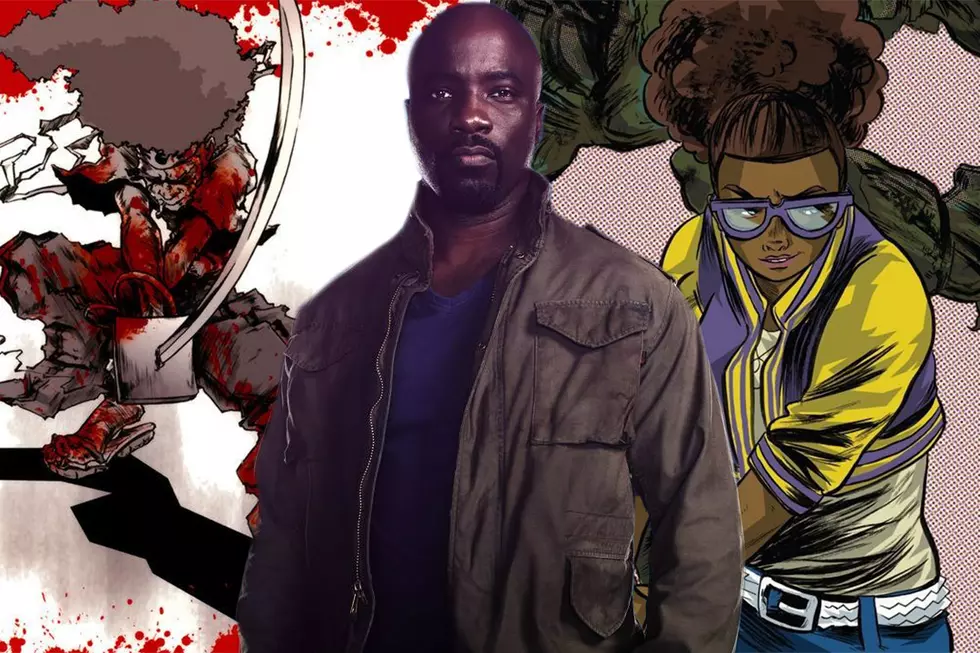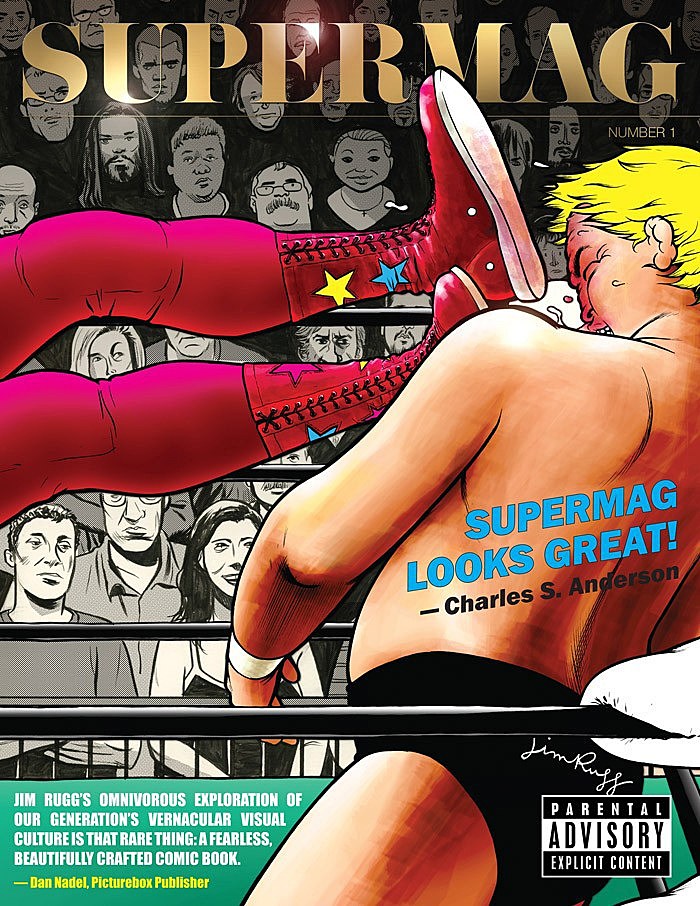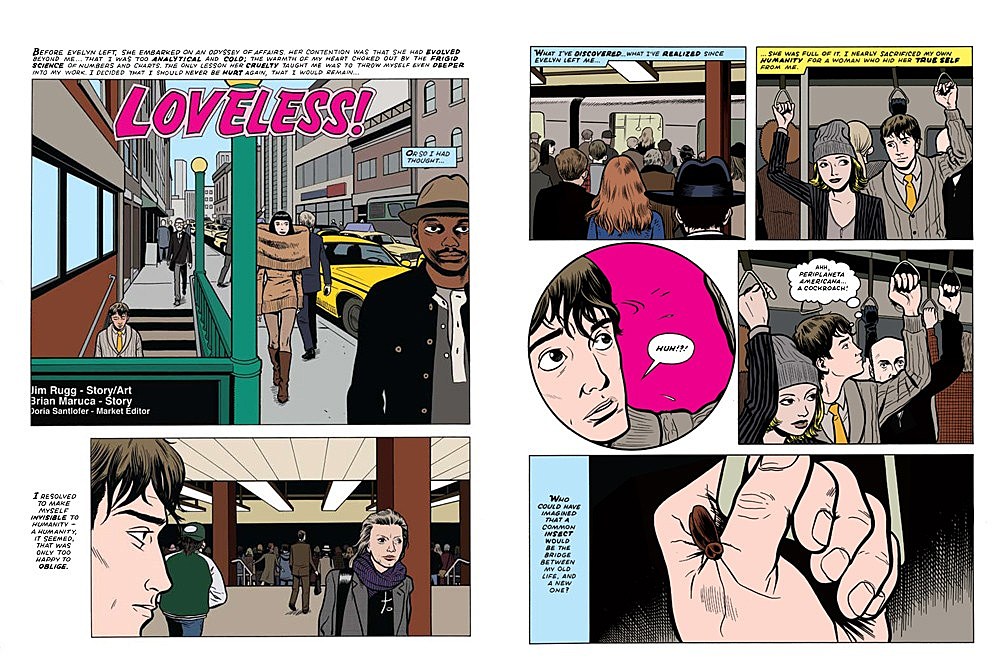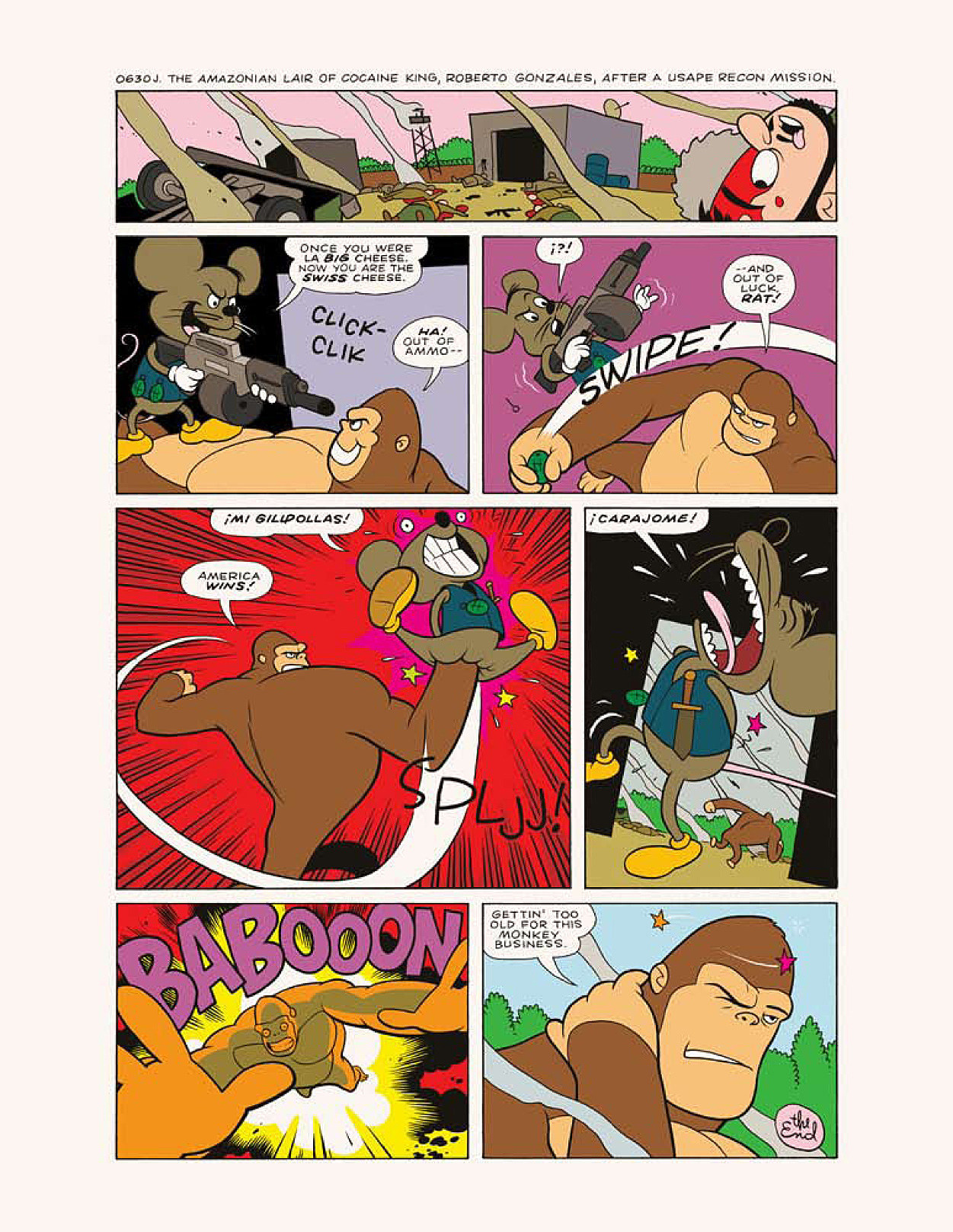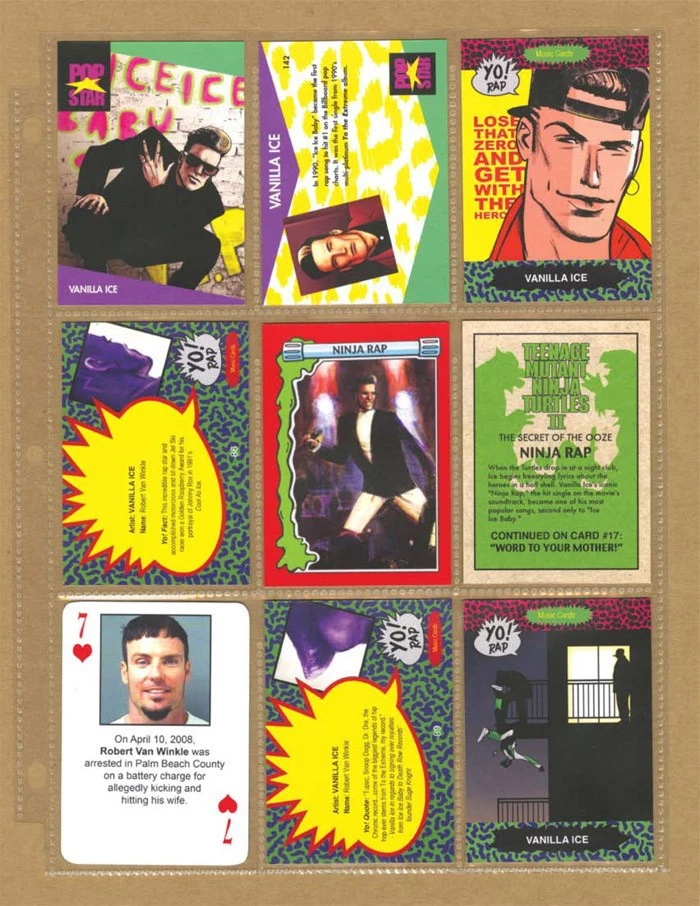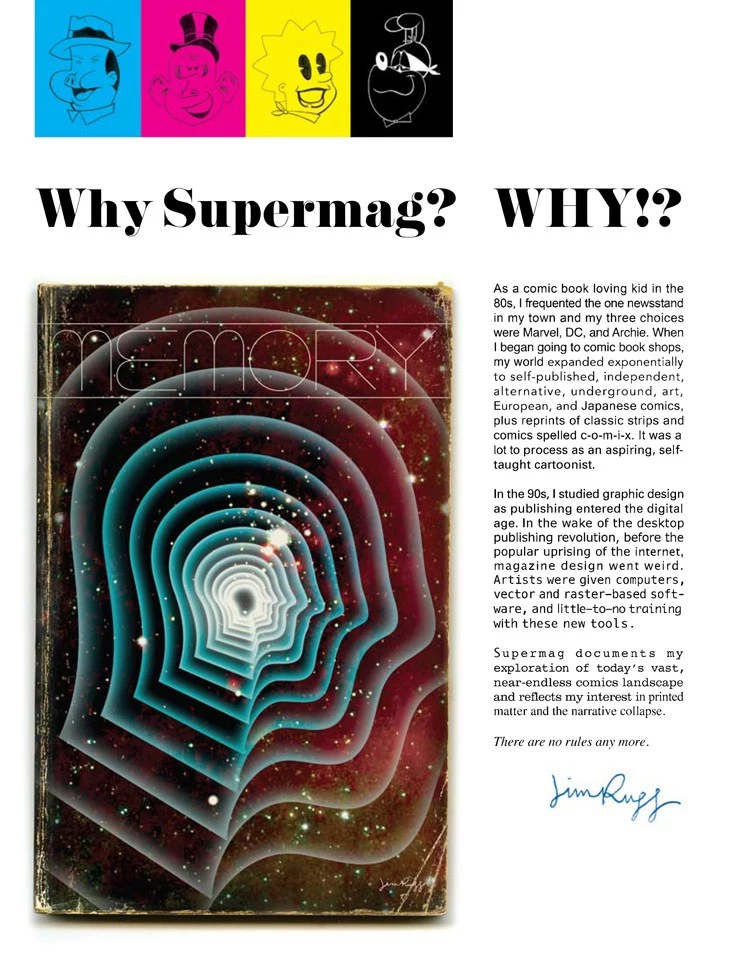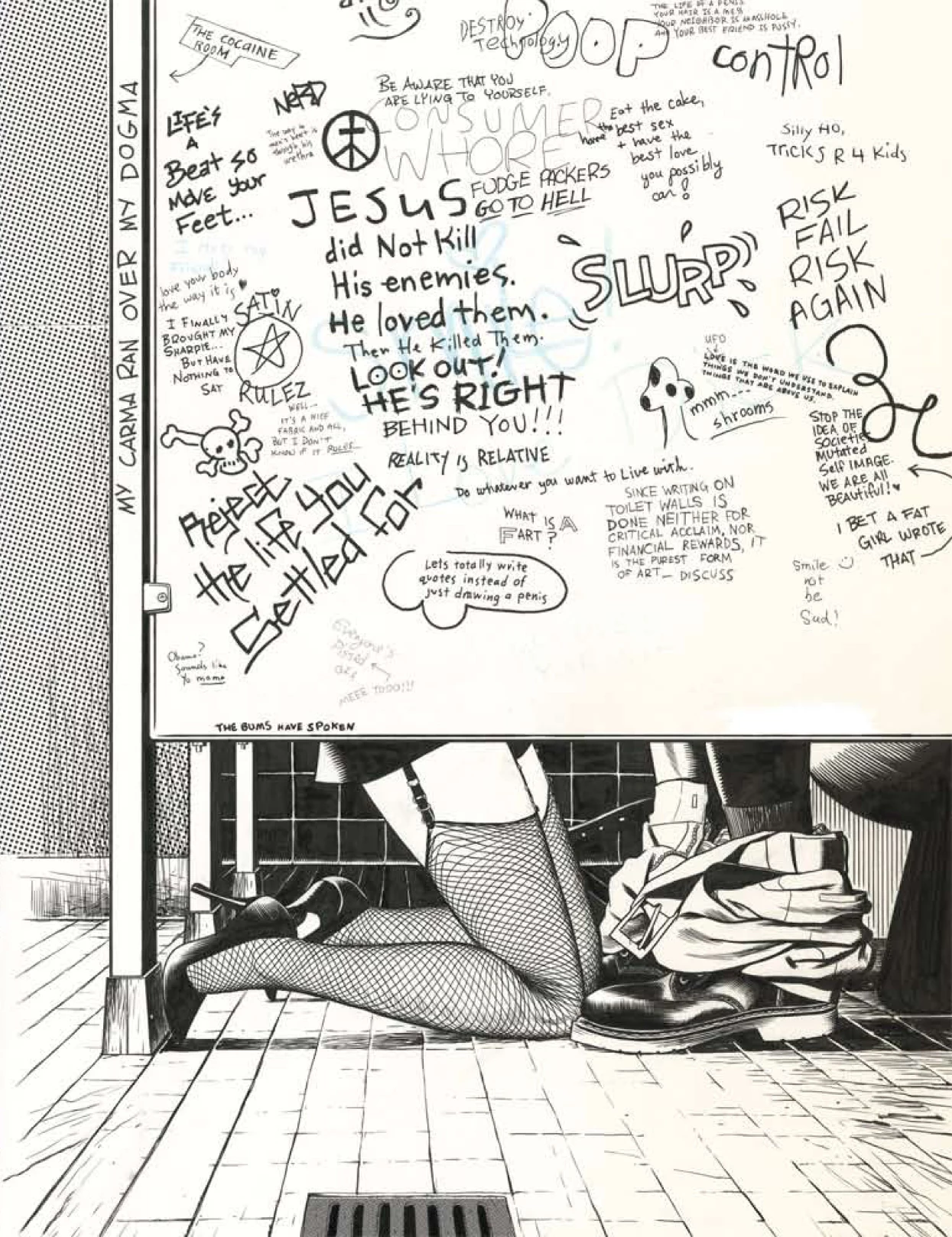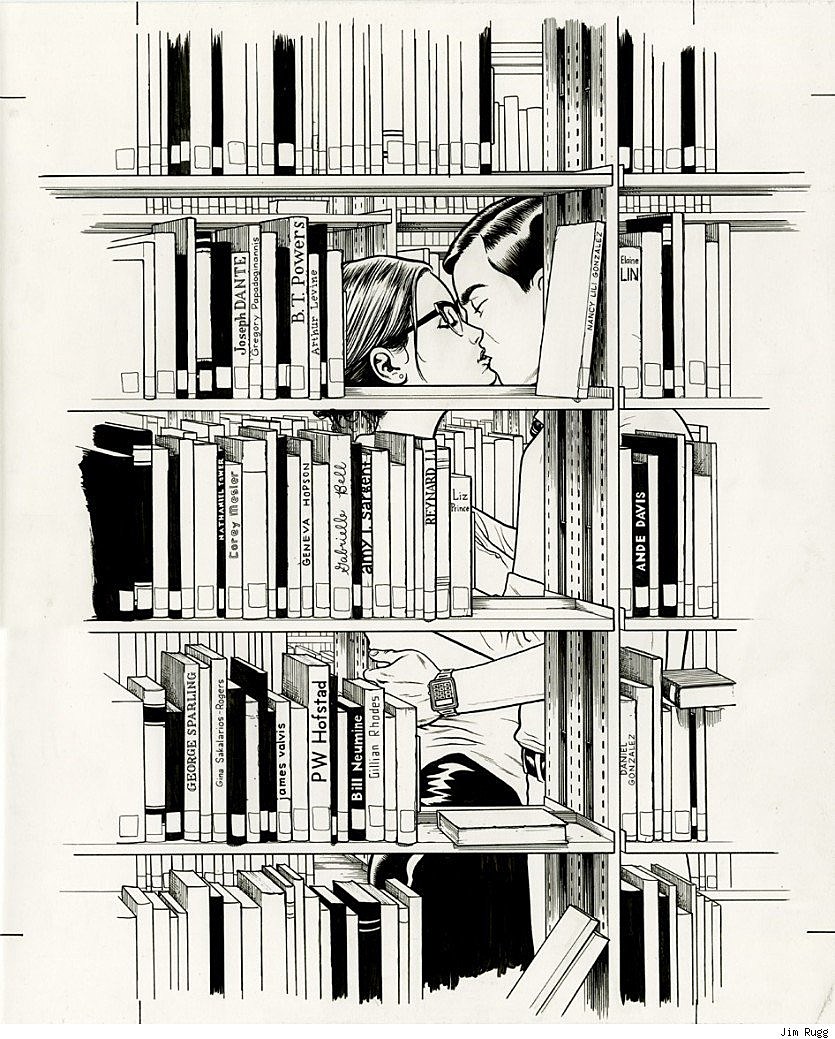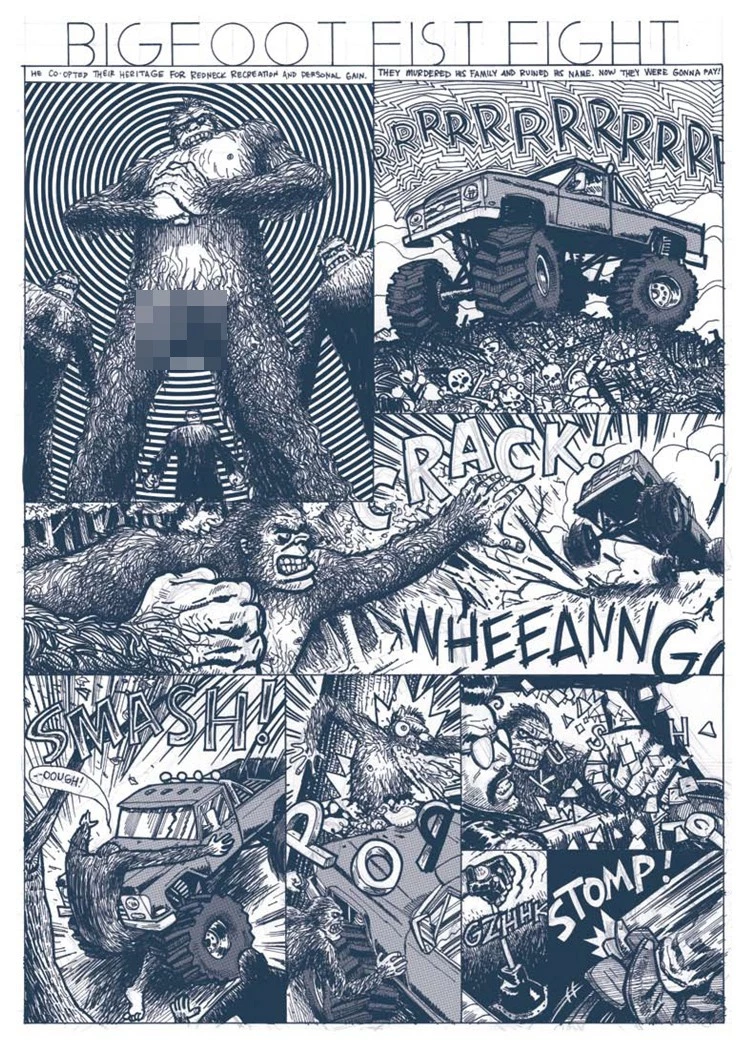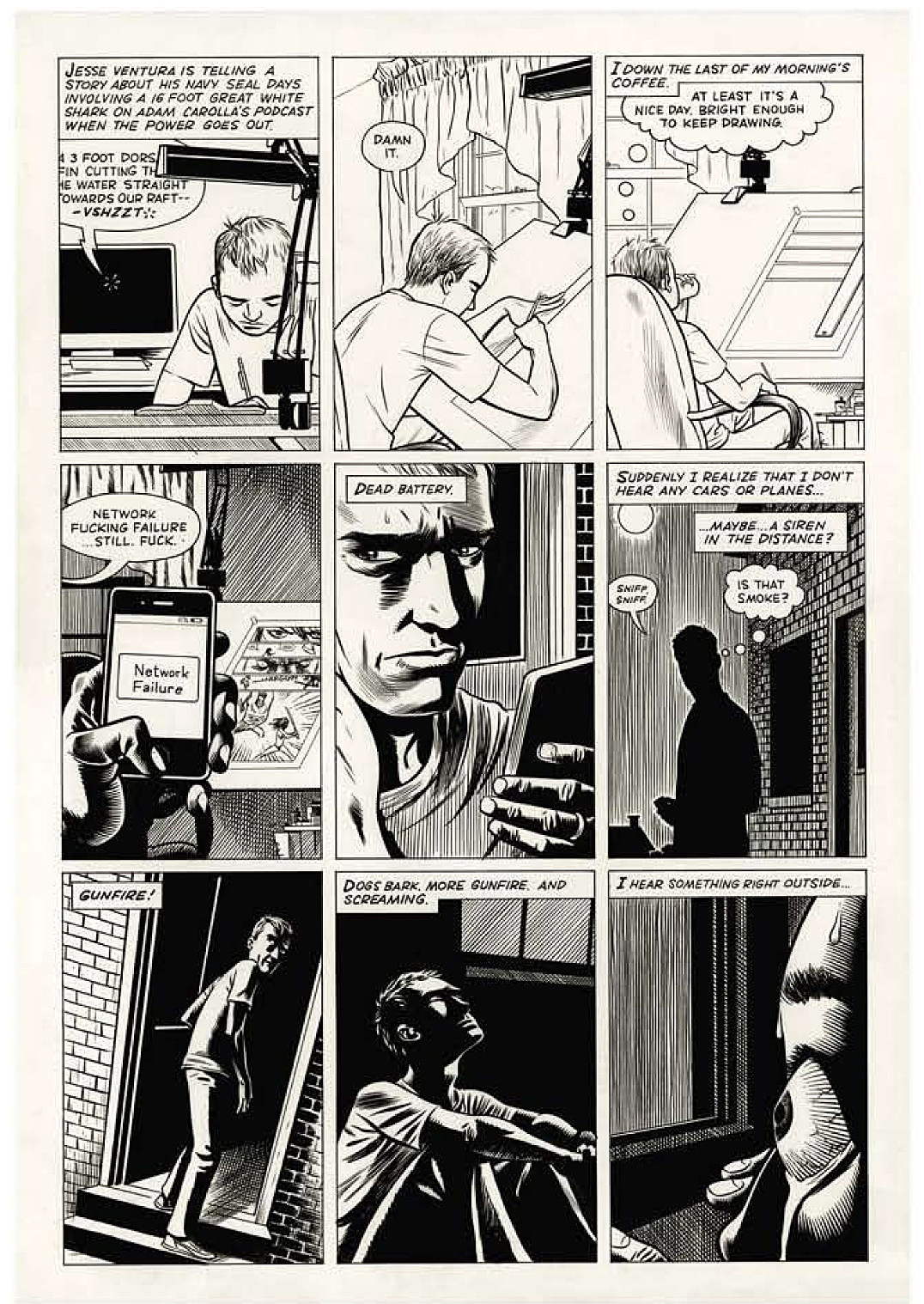![SUPERMAG: Jim Rugg’s Ambitious and Eclectic Comics, Illustration and Design Magazine [Interview]](http://townsquare.media/site/622/files/2013/04/untitled-4.jpg?w=980&q=75)
SUPERMAG: Jim Rugg’s Ambitious and Eclectic Comics, Illustration and Design Magazine [Interview]

"Print is dead," is a pithy saying that gets tossed around a lot these days. Well, apparently nobody said in front of comics artist and illustrator Jim Rugg (Street Angel, Afrodisiac, The Plain Janes). This May, Rugg will launch the first issue of Supermag, a 56-page, full-color, glossy magazine full of comics, illustrations, design pieces and more. Published by AdHouse, it's an impressive amount of work, with topics ranging from Nazi-fighting golfers, Vanilla Ice trading cards, adult theaters, killer gorillas, punk rock icons in love, and so much more.
In this in-depth interview accompanied by many pages of art, we sat down with Rugg to discuss all things Supermag, print, design, zine-making, creative process, Bigfoots, and why he believes there are no more rules in comics.
ComicsAlliance: How would you describe Supermag? Is it a design piece? A comics piece? The classiest zine ever made? All of the above?
Jim Rugg: In terms of a physical description, it's 56 full-color, glossy 8 1/2 x 11 inch pages of my comics, drawings, and designs.
I think it's clearly comics and design. The zine part is flattering because I've been looking at zines and talking to zinemakers a lot in the last couple of years, and that DIY-mentality has influenced me quite a bit. It's kind of a return to making mini-comics in a lot of ways because we figured out the specs for this thing based on a proposal I had to do for a magazine format book. Based on that proposal, Chris Pitzer from AdHouse Books put together some options for me --- like, we can do this many pages and maintain the saddle-stitching, and here are some different paper stocks that match your description, and on and on until we had the format completely worked out. But it was really a situation where we just kept working on this in terms of what can make with this timeline, budget, content, and so on. I wanted to make a zine, like a cross between a perzine and comic book. The magazine became the format and then it was just like build, build, build, rearrange, take out that page, bring in that other page...
We just have access to so much information now that we can make almost anything we can imagine, and in that sense it is a zine. I'm not sure there's anything I'd do differently with this project, y'know in terms of if I had a bigger budget or something. Working with AdHouse Books has been fascinating.
CA: It's very reminiscent of one-man comics anthologies like Dan Clowes' Eightball or Adrian Tomine's Optic Nerve, while still giving off strong vibes of design magazines like David Carson's Raygun run, the Emigré magazine and Seymour Chwast and Milton Glaser's The Pushpin Graphic. What else fed into Supermag?
JR: The accuracy of that list is astonishing. Eightball is my favorite comic. I've been a fan of Optic Nerve since it was a mini-comic. David Carson's Raygun was like a textbook when I was an undergrad. I had a subscription to Emigré at my first graphic design job and used to just look at it over and over and sort of half-understand what I saw. One of my favorite issues was all photographs of their old computer equipment which they kept kind of in storeroom because they didn't know what to do with it. That magazine was incredible and changed the way I thought. I just got my first issues of The Pushpin Graphic this year, so I'm behind on that one, but it's very fresh in my mind.
I self-published my first comics and attended SPX in 2000. I had never seen anything like that. It was a life-changing moment. I came home with boxes of mini-comics. Fort Thunder and Kramers Ergot. David Choe's Slow Jamz left a mark. Seeing some of these self-published, self-produced comics and zines just broadened the language for me. And it also inspired me because suddenly, my favorite comics weren't just written and drawn by one person, often they were even printed and assembled by that same person. Comic Art magazine was pretty important, too.
JR: Early Image Comics were big, specifically Nick Manabat's Cybernary backup in Deathblow #1-4, Stephen Platt's unreal mark-making in Prophet #5, Jae Lee's story in Youngblood: Strikefile #1-3 (second best superhero coloring ever; Batman: Year One is tops on my list), and a few others. I'll refrain from providing a top ten list. But I spent like six months going through those again and it was interesting. I feel dirty admitting this, but Wizard magazine.
I got this book called The Last Magazine by David Renard and it had beautiful photos of all of these magazines, "the style press" he called them. That was pretty influential and it was at the perfect time. I got it because of my work on Foxing Quarterly, and I kept looking at it more than the average book that passes across my desk.
The other big influence on me is media and format. When I was a kid, I would rent horror movies and watch them late at night after my parents went to bed. I started watching Texas Chainsaw Massacre and had to shut it off because of the 16mm film. It freaked me out. It was like home movies. It felt so real because of that film and because of the low-budget quality. And I think I've always been somewhat aware of that part of the experience. When I was really little I used to ask my parents about cartoons -- how did they work. I knew they weren't quite real people, but I couldn't figure out how animation was made. It was like magic of some sort, a science that was far beyond my 4 year old knowledge.
CA: Both here and in your previous work, you have such a variety of styles on display, from the Fleisher-esque clean animation style in "Duke Armstrong," some Eddie Campbell-esque slice-of-life cartooning, and photorealistic reproductions of '90s trading cards. Afrodisiac was a cavalcade of styles from throughout comics history, including the spot-on Extreme Studios-style pin-up that's also here in Supermag. How do these start off? Is this style-hopping based on the material, or is it a matter of, "I wonder if I can pull this style off?" and then having the piece come from there?
JR: I don't know what comes first. An idea happens, and then you just start kicking it around -- what's the best way to create a Vanilla Ice pinup? What if Afrodisiac was a '90s Image book? Afrodisiac happened because of blaxploitation. Once I started getting into blaxploitation - specifically the films of the '70s, I had to do a '90s version because my first exposure to blaxploitation was gangsta rap of the early '90s that referenced and sampled blaxploitation. So that is something I've been thinking about for a while and just couldn't come up with a script that made sense. That early '90s Image storytelling is so strange. In the end, it seemed like a pinup made the most sense for that concept.
Sometimes it's a question of can I pull something off. Lately I've been making 3D drawings, and they are totally based on that idea -- technically, can I do this? I like trying new things. I'm trying to allow myself to fail more and just rundown ideas and not worry about whether they'll work. It's pretty boring doing things when you know what the outcome will be. It's all about time, trying to create windows of time where I can just wander and balancing that against deadline-work. In many ways, Supermag is that experimental project for me. It's an opportunity to try some new things. And hopefully more of those things hit than miss for most readers.
CA: I think it's also worth noting that Supermag is a decidedly print-friendly magazine, with shifts in orientation, paper choices and techniques. In an increasingly digital environment, what is it about print that attracts you?
JR: I'm not sure. Maybe it's the tactile quality and the physical, tangible object. Digital media feels so ephemeral sometimes. Like if I don't check my Twitter or Tumblr feeds all the time I might miss something. Even something beautiful and worthy of more than a quarter of a second just disappears so quickly online.
I don't know. Printing technology is so widely available now, not just offset printing, but I have friends who own their own letterpresses and make their living printing, and then use that equipment to produce their own incredible work -- zines, books, whatever. As creators, we have access to risographs, screen-printing, photocopiers, drawing tools and inks and paints from all over the world. I've been making comics for almost 15 years. When I began, the idea of doing a color, offset book was ridiculous. Now it's possible to create these dream projects. That opportunity may not come again, but for Supermag, I had a chance to create a full-color magazine. That's something I've thought about doing for 25 years.
So I guess part nostalgia and part opportunity to try to make something interesting.
CA: On the back page of Supermag, you have a list of ingredients that run the gamut from comic books and graphic design to sable brushes, the 1990s and narrative collapse. While you were pulling all of this together, did you worry about it being too much of a grab bag?
JR: Not really. Now that I have a copy I worry about it, but that's just my nuerosis. If it weren't that, I'd worry about some other detail. Supermag's contents are pretty weird. But I like weird. One of my favorite qualities of comics is that because they are produced with so few hands, they have the potential to be very unique and personal visions -- i.e. weird. That creative model has the potential to capture the point of view and quirkiness of the person or people who create them in a way that a film or larger creative collaboration can't. I'm sure it will be too much of a grab bag for some people, but we didn't print enough for everyone to have a copy so it's okay if not everyone wants one I guess.
I'm terribly insecure about this kind of work because it is personal and different and not for everyone. As a result, I try to overcompensate. So while I'm sure it won't be everyone's ideal, I don't think anyone will feel disappointed in the effort.
I think if you enter Supermag with the magazine layout in mind, it fits together better. For instance, the first few pages mirror the advertising structure of traditional trade magazines (everyone loves Mad Men, this is the domain of their type of work). Then there's the editorial page, a series of shorter strips, like magazine features, then longer features with sporadic advertising mixed in...it's not as random as it may appear at first. There's an effort to create that sort of rhythm or pacing of a magazine.
CA: In the "Why Supermag?" page, you sign off with the line, "There are no rules anymore." Can you elaborate on that?
JR: Growing up, it seems like people lined up to tell me how the world worked and to prepare me for the real world. As an adult, it turns out that my experiences in the real world are a lot different than my expectations and in hindsight; a lot of my preparation was misguided. As a result, I now approach everything as though I don't know anything. When I want to make something, I just start researching it. So far, I haven't encountered anything that I'd consider impossible. A lot of it is difficult, but none of it is impossible.
The Internet has created a world where we have access to the knowledge and experience of millions of people. And what I've discovered is that for every rule I learned growing up, I've met people who are exceptions or have experienced exceptions to that rule.
For instance, at different points in my comics making experience I've been told that you have to make comics a certain size (6 5/8 x 10 1/4 -- the standard comic book size). I've been told this by cartoonists, publishers, and retailers. Of course many of my favorite comics are not that size. Where would Building Stories be if it adhered to such a rule?
When Afrodisiac was published, it far exceeded my expectations in terms of sales. I had editors and retailers tell me how much they liked it, but the cover didn't have a title on it. Big mistake. When I asked one retailer, who told me about this mistake, how it did in his store, he said it sold very well.
I have really great comics that have no words, that have been silkscreen-printed, or drawn with nothing but vector art... it doesn't matter what tools or approach is used to create work anymore. Whatever model someone wants to follow to make their work, I bet you can find examples of people who have done great work using that model.
I think the binary metaphor that I grew up with right/wrong, either/or, etc., just isn't accurate today. I learned this through Photoshop. I went to college with Jasen Lex, and we started using Photoshop in '95. So whenever we collaborate on something, sometimes we'll be in the same room, working on one machine. We can arrive at the same effect, but our process to get to the same point is completely different.
There are more ways to skin the proverbial cat than one person can explore in a million lifetimes. Every day it feels like someone does something new and different in terms of producing work or distributing work or selling work. No rules. Not anymore, and I often wonder if there were ever rules because I can't find any. I wish I could. Life would be much easier if we didn't have an infinite amount of choice all around us. But unfortunately, every time I think I've found a rule, I find an exception.
CA: You recently art directed two issues of Foxing Quarterly magazine, the cover of which made its way into Supermag (and ComicsAlliance's Best Art Ever). How did you get that gig and what did you take away from the experience?
JR: The editors of Foxing Quarterly contacted me about producing a cover for the first volume. As we worked on it and communicated, the topic of art direction came up. I've always wanted to art direct a magazine project. We realized that it might be a good fit and so we did it. It's been a great experience so far. The Foxing Quarterly team has been extremely supportive of my ideas and designs. One thing I take away is that collaboration is good. Another is to just try things, because it's hard to know what will work before you do it. And without the Foxing experience and the research that involved, Supermag almost certainly wouldn't exist.
CA: How does it feel to know you've drawn the best Bigfoot versus a monster truck comic of all time?
JR: (muffled sob?) Th-thank you! It is a relief to finally scratch that one off my to-do list. I've been drawing Bigfoot trucks since I was six. It's great to get that monkey off my back! The only thing I can remember drawing before I started drawing Bigfoot trucks was dinosaurs. (Stephen Bissette's Tyrant and Mark Schultz' Xenozoic Tales were a couple of my favorite dinosaur comics.)
CA: What things have you seen lately – comics- / design- / illustration- / other-wise – that has really inspired you?
JR: Object 5 by Killian Eng, published in 2011 by Floating World Comics. It's a small, full-color book of drawings that look like a cross between '70s/'80s sci-fi cartoons and Moebius. It's not exactly a narrative, but it feels like a narrative... it's beautiful.
Fukitor, a series of full-color mini-comics self-published by Jason Karns. It's printed on newsprint by the artist with adjusted amounts of ink so it looks like faded, old comic books. The stories and art are NC-17 levels of offensive in terms of sex and violence. And they are incredibly well drawn and very funny. Not for the faint of heart I suppose, but damn near perfect objects. If underground comics and EC had degenerate offspring, it would be Fukitor.
SSE #20: Where Is My Super Hero by Sung Mo Kang, (SSE project). Full-color, mini-comic/zine hybrid. This is part of SSE project, an online gallery and zine thing. Interesting drawings that show a comics influence, lettering is part of the drawing, and there's a suggestion of narrative. If you click on their shop button, you can see good previews of all their zines. I want them all.
Windows of New York by Jose Guizar may be the most beautifully designed website I've ever seen.
The Wally Wood and David Mazzucchelli artist editions from IDW. Back issues of Comic Art magazine. Somehow those look better than the day they were published. I loved the color and lighting in Spring Breakers. Oh, and the work of Uno Moralez. His work almost defies description. He makes illustrations, comics, and animated GIFs in a style that is like early bitmap images. In comics, the only thing that looks similar is Shatter, and that's not a good comparison at all. When I was rambling about the "no rules" thing, this guy could be the champion of no rules. His work is amazing, and it's hard to believe it works at all.
I'm sure I'm forgetting a million things...
CA: What are you working on now? What's next on your plate?
JR: Drawing. I have a show coming up in August at iam8bit in L.A. It seems like it's going to be drawings that have lettering in the drawings. As part of this process, I've been posting drawings more frequently online. My tumblr is probably the best place to see those. It's fun. I had a show there last year that was ballpoint pen drawings on notebook paper. And that was a great experience. It's been amazing just drawing whatever I think of. That sounds obvious, but I had gotten into the bad habit of drawing mainly for work. So these shows have been very rewarding in that they require me to just draw for the love of drawing. It's like being a kid again.
I also produce a podcast called, Tell Me Something I Don't Know on Boing Boing with Jasen Lex and Ed Piskor. We talk to artists, cartoonists, musicians, filmmakers, journalists, and other creative people about their work and the reality/business behind what they do. We just started our second season. Previous guests have included Gary Groth, Faith Erin Hicks, Mike Mignola, Matt Furie, Rob Liefeld, video-game designer Jesse Schell, and many others.
I'm not sure what my next comics project will be. I am looking at a couple of things right now. My summer's pretty booked with work and touring. I'll be at TCAF, Phoenix Comicon, and Heroes in May and June. Then LA for the Supernerd opening and Autoptic in Minneapolis in August. Before you know it, it's back to school time!
CA: Finally, who do we talk to about getting a "Duke Armstrong: World's Mightiest Golfer" ongoing series?
JR: Brian Maruca will be happy to read that.
Supermag goes on sale this May from AdHouse Books.
More From ComicsAlliance
![I’m A Maniac For Flavour! ‘All-Time Comics’ Taps Into Old-Time Ad Nostalgia [Exclusive]](http://townsquare.media/site/622/files/2017/03/atcads_featured1.jpg?w=980&q=75)


